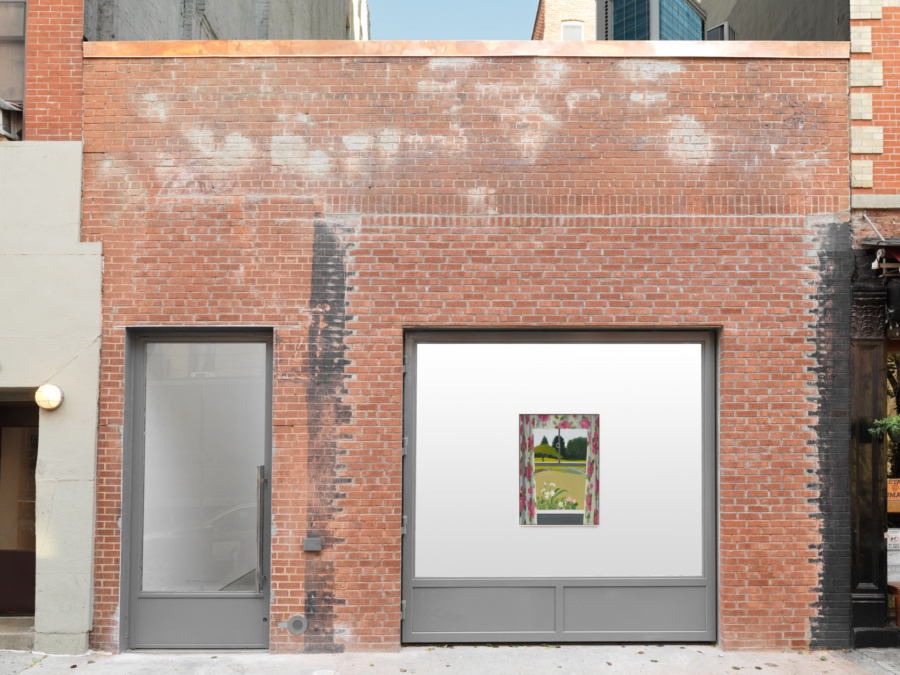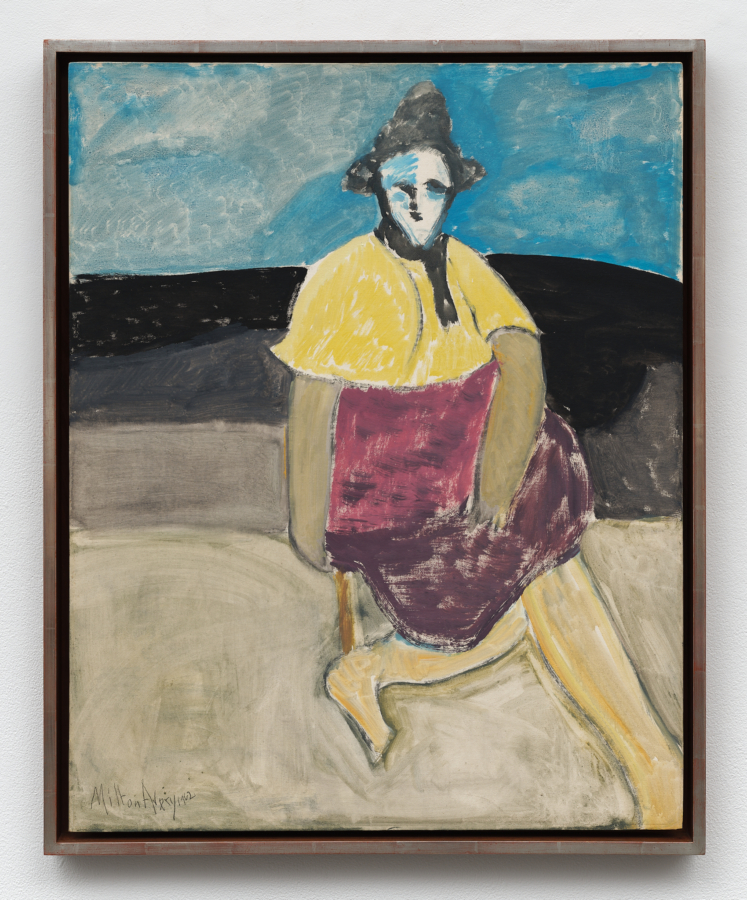2021
Heitzler, Drew, “Large Ludicrous Picture Painting,” Conspiracy of Asses, Brussels: Triangle Books, 2021, pp. 92-93
What do Calvin Marcus’s paintings do?
Not such a tough question I suppose. The work begins with watercolor on paper, politely proportioned as watercolors generally are. The product of table and stool. The tinted fluid drawing operates as the epistemological foundation for the work. The images, tied directly to the title phrases operate as ideogrammatic texts, longwinded icons. Los Angeles Painting, Conspiracy of Asses, Tall Snowman. Ghost of Younger Self. It is here that meaning in this work takes its first steps. The subjects are impolitically correct and knowingly derivative. Inauspicious one might think. And then Calvin makes them large. This is not uncommon, to work out a painting first as a drawing. What is uncommon here are the lengths the artist goes to in the reproduction of the drawing quality. Canvas is customized to take on the tooth and absorption of paper. The watercolor is scanned and enlarged through projection. Negatives pace is manipulated flatbed picture plane style, with acrylic, water, and compressed air. Positives pace is painted by hand. In the end we have a painting of a projection of a jpeg of a watercolor. A monkey-wrenching of the cyber that traverses the gap between artwork and network both literally and metaphorically A. process that starts with the hand, then moves through the computerized and the mechanical to arrive transformed at the hand once again. A pie of a drawing projected as a painting of a picture.
What do Calvin Marcus’s picture paintings do?
Well, most obviously, they scale. A tricky word, this one, mostly associated with tech-sector IPOs but for our purposes a prescient etymology would reference history painting from the camera lucida days, Abstract Expressionism, Systemic Painting, all those post-1945 German pictures, and SoHo in the 1980s. Scale, in this sense, is a function of the narrative construct. An embodiment of the ontological, confronting the viewer as epic and so becoming epic, becoming large. But Calvin’s picture-painting, even with content scaled to gigantic, never really scans this way. The flaccid lyricism of the watercolor defies the epic nature of the erected painting (and vice versa). In other words, the modest quality of the drawing undermines the painting’s authority while in turn the painting’s historical baggage questions the drawing’s emotional modesty. In this precarious state the work seems to time travel, haunted in its present wax by the spirit of its own inevitable wane. Think old man Guston cock-and-balling Nixon’s visage or a fucked up Kippenberger fiddling with his bolognese recipe at Capri and you’d be in the best head to consider the frustrated, lackadaisical, even anodyne power relations going on in these large picture paintings.
What do Calvin Marcus’s large picture paintings do?
They scale, as noted, and then they repeat. Ludicrously these off-color vulgarities of scale repeat themselves, the repetition made self-referentially part and parcel to the vulgarity itself. This practice of repetition predates Calvin’s practice of scaling and has progressed with successive bodies of his work. In the Green Calvin series the objects themselves repeat (minor difference of facture aside). In Me With Tongue and Were Good Men repetition occurs in the painting’s subject matter. In the Malvin Carcus paintings and now in this current body of work seriality occurs as device. With this in mind, repetition may be considered the more vital of the two operations identified here as essential qualities. It also represents a crucial difference between size and scale. In general, we think of size in linear terms, units repeating in succession. By contrast, scale is dimensionally exponential, a result of mathematical projection with Euclidean roots in the phenomenon of shadows cast by real world objects. Repetition, as a means of occupying physical space, is fairly efficient. Scaling, in conceptual terms, is even more so. Both, as a matter of form, are pragmatic.1 Pragmatism interestingly is the one school of philosophy fully developed in the United States, which may explain why theses meticulously bad picture paintings feel very American. Feel specifically suited to the irony of a hyperconnected society that still doesn’t seem to go anywhere. It is within these static currents of social fluidity that Calvin’s ludicrous repetitions of the anodyne work out their own social fluidity and currents of stasis.
This is what Calvin Marcus’s large ludicrous picture paintings do.
An earlier generation would stop here, would find the work’s means within its framework. But we live in a different kind of time, situated more closely to a view of art work as a temporal worlding as opposed to a spatial en-framing. A “How” in time rather than a “What” in space.2 With this in mind we must now consider the “How” of Calvin’s work. How do Calvin Marcus’s large ludicrous picture paintings do? In my approach to this question, I kept returning to the work of Benjamin Noys, a political theorist popular with Occupy Wall Street and Antifa in the early 2010s. An odd association I admit, but one I hope to show is not entirely without merit. In The Persistence of the Negative ( 2010), Noys identifies our contemporary condition in relation to Walter Benjamin’s assertion that creativity flatters the self-esteem of the productive person while guarding the interests of a social order that is hostile to him, a situation made more extreme as market value overtakes social value. Traversing this condition requires, Noys argues, a hijacking of Bertolt Brecht’s plumpes Denken in order to employ Friedrich Nietzsche’s untermensch as a secret agency capable of restraining the commodification of existence. Vulgar thinking, in other words, geared not toward revolution but instead toward reparation, is required “to truly grasp a concept of collective political agency that can wrest freedom from necessity.”3 This form of vulgar thinking I find at the heart of Calvin Marcus’s large ludicrous picture paintings. Indeed I find it at the heart of his entire project. A project in which “Action can, of course, be as subtle as thought,” as Benjamin teaches. “But a thought must be crude in order to come into its own in action.”4
“Don’t start with the good old days,” says Brecht, “but with the bad new ones.” Every artist must play the hand they are dealt, and Calvin’s vulgarity arrives at a specifically vulgar time. The last days of the art world are upon us, says the vulture. The sickness in the air has mingled with the sickness of populist authoritarianism to expropriate vulgarity to its cause. As Adorno and Horkheimer warned it would, this tool of social liberation has been transformed into an ideological weapon. A means of oppression. How can art work to shake off this appropriation? Not as neo-Gramscian social activism or neo-Situationist media hack, but as artwork? Expropriate the expropriators, writes Noys. Materialize infiltration and sabotage as disguised yet persistent formal resistance.B ring to light the precarious reality of contemporary life and so point to a better future.5 But persistence here insists upon an understanding of art work as temporal unfolding, an activated “How” that begins with the Geist, that spirit that sees all material as vulgar, always impure in relation to knowledge. It is in the dematerialized then that we would expect to find this Hegelian ideal, yet it is within the net of cyber-social mediation, the pinnacle of dematerialization that knowledge is most thoroughly vulgarized.6 Through scale and repetition, Calvin Marcus’s large ludicrous picture paintings make use of and mimic these tech-bro devices, but only backwardly, badly, and by hand, vulgarizing the vulgarizers. Recalling that the joker is the only card that may insult the king, Calvin’s anodynamism operates as an agency of restraint, “keeping the culture moving,” as vulgarity punches up from below the belt. The work kills, but keeps its head. Like a spot-lit stand-up one wrong word away from cancelation, this bit of contradiction plays the brightly colored heel, skipping on eggshells through the dark comedy of our real.
This is how Calvin Marcus’s large ludicrous picture paintings do.
1. This difference is succinctly illustrated in Calvin’s most recent exhibition GO HANG A SALAMI IM A LASAGNA HOG, at David Kordansky Gallery in Los Angeles, in which the first space presented several of the large picture paintings, while the final space presented Stretch Sturgeons, three paintings depicting the eponymous fishes elongated through systemic repetition to the length of a limousine. The second space exhibited two more lessons in scale: Corner of Main and Hancock (2016), a small-scale model of the artist’s studio building complete with interior lights and functioning whirly bird, and Asparagus 7 a.m. (2019), a framed four-by-five photo of what appears to be a plate of asparagus but is in actuality a 10-foot fabricated sculpture composed of polyurethane foam, fiberglass, and yucca stems.
2. For more on this Heideggerian concept see Pamela M. Lee, Chronophobia: On Time in the Art of the 1960s (Cambridge, MA: MIT Press, 2004).
3. Benjamin Noys, The Persistence of the Negative (Edinburgh: Edinburgh University Press, 2010), p. 19.
4. Walter Benjamin, Understanding Brecht (New York: Verso, 1981), p. 81.
5. In Bad New Days: Art, Criticism, Emergency (New York: Verso, 2015), Hal Foster traces such a strategy from Clement Greenberg’s painterly self-definitions, through T.J. Clark’s practices of negation, to Molly Nesbit’s articulations of the precarious as art-historically pragmatic. A good read. Check it out.
6. Thanks here to Jan Tumlir for his thoughts on Hegelian Geist and the internet as ultimate site of both dematerialization and vulgarity.



